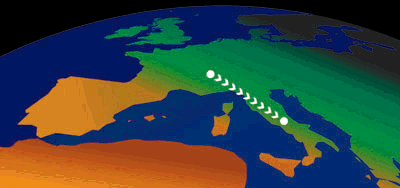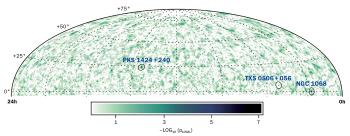
In a move that significantly extends the scope of European collaboration in particle physics, CERN is collaborating with the Italian National Institute of Nuclear Physics in a new project. A beam of high-energy neutrinos will be sent from CERN to detectors that will be built at the Italian Gran Sasso Laboratory, 730 km away from CERN, and 120 km from Rome.
The first historic Alpine crossing was General Hannibal’s march on Turin, in about 200 BC. The advent of modern communications brought a need for transalpine railway links. The first tunnel to breach the Alps was the 14 km Fréjus/Mont Cenis tunnel, the construction of which began in 1851. It was soon followed by the 14 km St Gotthard tunnel in Switzerland. Now physics crosses the Alps too.
However, neutrinos need no tunnel to cross a mountain range – most of them can pass through rock. Contemptuous of matter, a neutrino beam can even pass through the 13,000 km of the Earth and emerge on the other side. There is, however, a slight neutrino casualty rate that makes experiments with neutrinos possible. If there are plenty of neutrinos, it is probable that enough of them will interact to produce a detectable signal. Of the 1018 neutrinos to be sent to Gran Sasso annually from CERN, about 2500 will interact, en route, with each 1000 tons of target material.
It took about half a century to discover that the neutrino (nature’s most unpredictable particle) comes in three different kinds – electron, muon, or tau – according to the type of weakly interacting particle (lepton) they escort. Physicists are now convinced that these three varieties of neutrino are not immutable, as was first thought, but they subtly rearrange their lepton allegiance in flight. In physics language, the neutrinos oscillate from one kind to another as they travel.
Positive evidence for neutrino oscillations so far comes, overwhelmingly, from extra-terrestrial neutrinos: from the Sun or from the interactions of high-energy cosmic rays in the atmosphere. To probe these oscillations under controlled conditions requires synthetic neutrinos. These neutrinos are produced via the decay of high-energy particles, which are generated by beams in an accelerator. The oscillations depend on the distance between the neutrino source and the detectors – the baseline.
For the new project, protons from CERN’s SPS synchrotron, with an energy of up to 450 GeV, will be focused on a target to produce pions and kaons. These particles will then be magnetically focused to point towards the Gran Sasso Laboratory. After about 1000 m, most of these pions and kaons will have decayed, producing electron- and muon-neutrinos. The remaining strongly interacting particles will be removed by a beam stop (which the neutrinos can hardly “see”). CERN will construct the neutrino source, while Gran Sasso will host the detectors and provide the infrastructure at the far end.
After an initial round of proposals for experiments to detect the neutrinos, two – OPERA and ICANOE – are well defined. OPERA will use the emulsion target techniques developed for the CHORUS neutrino experiment at CERN, and further refined for the DONUT study at Fermilab. While CHORUS used a mere 700 kg of emulsion, OPERA will use 200 tons of emulsion, which will be interspersed with thin lead plates. Vital to this work are Japanese emulsion technology and sophisticated automated emulsion scanning techniques, developed in Japan and in Europe.
ICANOE is based on the liquid argon detector used to track and identify particles and developed for the ICARUS neutrino detector. It will be supplemented by the NOE magnetized spectrometer. ICANOE will use 9.3 kilotons of liquid argon in four modules, which will be separated by NOE spectrometers.
The main goal is to see the appearance of tau neutrinos in Gran Sasso. These particles will not be present in the beam when it leaves CERN, but may be produced en route.
Data taking for these new experiments is planned to begin in May 2005. In addition to existing equipment at CERN, two-thirds of the 71 million Swiss francs needed for the project is being provided by the Italian National Institute of Nuclear Physics (INFN). So far voluntary contributions from Belgium, France, Germany and Spain have been announced.
Long baseline neutrino studies are under way in Japan, where the KEK Lab sends particles to the 250 km distant Superkamiokande detector. In the US, the MINOS project is sending particles from Fermilab to detectors in the Soudan mine, 730 km away. The main thrust of these studies is to chart the disappearance of neutrinos that were initially present in the beam.







